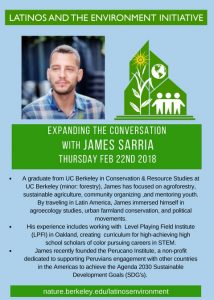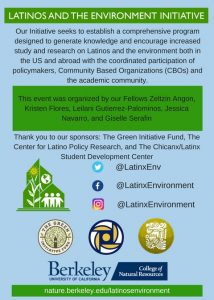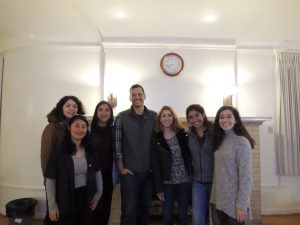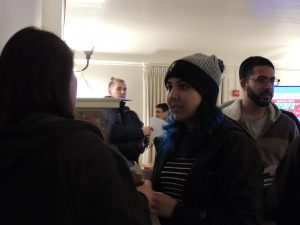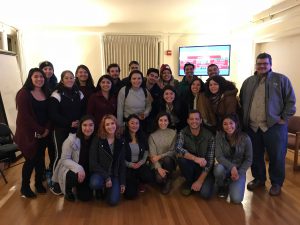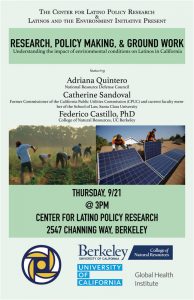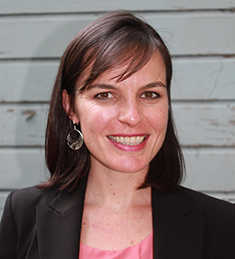 Sarah Sieloff- Director of the Center for Creative Land Recycling
Sarah Sieloff- Director of the Center for Creative Land Recycling
Oakland’s Center for Creative Land Recycling
Sarah Sieloff directs the non-profit Center for Creative Land Recycling (CCLR or “see clear”), one of Oakland’s own, an organization committed to transforming communities through land recycling. CCLR’s work facilitates the redevelopment of brownfields (vacant, abandoned or contaminated parcels) to support sustainability and environmental justice. Throughout the past 20 years, CCLR has provided technical assistance to hundreds of communities, and has helped these same communities win millions of dollars in federal and state grants to support land transformation projects around the country. These projects have removed environmental and human health hazards, replaced wastelands with urban oases, and created community assets in the form of jobs, new tax revenues, and beautiful spaces. CCLR’s work brings together local non-profits, government entities, and communities “from the neighborhood up” to consistently achieve effective land reuse catalyzed by local imagination.
What are the most successful projects that you have seen CCLR take on?
CCLR worked with the community of San Pedro in Los Angeles to turn a vacant lot into a neighborhood park. San Pedro is majority Latinx community. It’s located close to freeways and industry, which raises many environmental justice and health issues. Residents love their community and wanted to express that San Pedro is a great place to be. CCLR helped San Pedro fund the community outreach and design process that led to a conceptual design of the park. Today, San Pedro welcome park. It’s a lovely little park, it’s right off the side of the main road that goes into San Pedro and it has some street furniture, some places to sit, a flagpole, some greenery. It looks a lot better than it used to. And most importantly it’s a great way for the community to express to the world that this is their little spot and they are very pleased and happy to be there and welcome to their neighborhood. I should say the community did a lot of beautification work on that parcel that was driven by them for them. So you can really see how without engaged neighbors, nothing would have really happened there, or less would have happened.
Another example, if you drive or travel through the East Bay, you may have seen Union Park. the park is right outside of Alameda on the other side of the estuary. It’s at the park street bridge practically, it’s on the embarcadero in Oakland. That parcel, well water fronts have been working areas for a long time, and in the Bay Area we are no exception so this particular parcel of land was an all purpose industrial site. Contaminated with oil solvents and other chemicals that come with years and years of storing vehicles and producing chemicals who knows what else. The Unity Council, which is an organization based in Oakland, worked with the city of oakland to turn that parcel into a park and that required assessing the parcel to better understand how it was contaminated and with what it was contaminated and with what and also cleaning it up and remediating it. And again, this happened before my time but I love this story because it think it really shows how an engaged community with a local champion in this case a local non-profit really made the difference. Because when the clean up started it was shown that there was more pollution than had originally been expected, so we realized that the clean up was going to be much more expensive that what originally was expected and anticipated. The Unity Council is a massive non-profit but no non-profit can absorb massive increases in cost/budget unexpectedly and be okay. There was a breaking point where there was a choice. In order to scoop out and remove all the contaminants and say, send out on a train either to Utah or somewhere else in California that was going to cost way more money than anybody had on hand. The alternative was working with regulators and a landscape architect who was actually brought in from Mexico to find a way to contain the contaminated soil on site and that really reduced the cost of remediation while still protecting human health and the environment. And today when you drive past Union Park, you may notice a large mound, and its really Nicely landscaped, there’s a path you can walk up, beautiful native plants… At the core of that mound, deep underneath impenetrable barriers and several feet of clean soil, in addition to the landscaping, is the contaminated soil. Long story short, it’s a pretty great story because the understanding of the clean up practice. Union city made that all possible. If you look at the waterfront on embarcadero, Union Point Park is a important node of green space because lots one of the few green spaces on that water front for a significant length of the area so it makes a positive contribution to the city to the surrounding neighborhood and this is all . Thanks to the Unity Council. And I should say, I was really fortunate to meet Arabella Martinez who was one of the directors of the Unity Council at the time and is a community activist, I think she still may be involved with the Latino Community Foundation, she was their interim executive for a while. But she is just phenomenal and One of our interns a couple of years ago did an interview about a separate project that they did in Fruitvale. And it’s an amazing story and Arabella pulls no punches and it just a formidable and phenomenal community activist.
Third one that is more recent: A good example would be Puerto Rico. In PR, there are a lot of challenges we don’t necessarily see on the mainland. The island is continuing to recover from the hurricanes. Sometimes when new mayors are elected at the municipal level, and those mayors come from a different party, the transitions between administrations is not always smooth and that can create challenges to continuity for things like Federal Grants. So we have seen situations where the change in administration can kind of lead to grant funded projects being stranded. That is an issue on which we are consistently working on and that we are building staff capacity for in Puerto Rico, so that does not have to happen. One projects that has been super successful I think on the Island is an assessment and planning project on the southern part of the island, its close to Ponce and Guayama and it deals with redevelopment of a substantial tract of land that is a former oil refining facility. This is the World’s Second largest petrochemical area on the planet, so there have been EJ concerns in this area for a very long time.The local council of governance for Southern Puerto Rico, which the full name of the organization is Desarrollo Integral del Sur, and they go by DISUR. They have spearheaded the application and management for multiple EPA grants which has given them the funding to be able to plan for an EcoFriendly business park, so there is a planning element that is very community based and very inclusive, and they also have some money to to assess different properties. So for example they have made it a point of working with mayors of nearby small towns to do help things like assess old gas stations, vacant sites, industrial sites that have been vacant and no one knows what used to be on them and one knows whether or not they are contaminated and whether or not they can be redeveloped. That has been a great success story in Puerto Rico where you’ve got a local council of government. With ties to mayor and community, but is taking the lead of not only bringing federal resources to these communities and helping to manage them and putting them to good use. As I’m sure you know, finding a grant is one thing but having the skills for management and putting together a program of management of those grantsv is another thing. So those skills don’t necessarily always come together. But we have really seen that work really well with DiSur in SPR. Another story, another angle, kinda shows how it’s great to cut a ribbon, but most of the time it’s a long hard slog to the finish line and that is why every step along the way is very meaningful and really important, and we try to make sure we are helping to tell these stories of interim steps of that equal success.
You attended our inaugural Latinos and the Environment Summit on April 5-6. What attracts you to the Latinos and the Environment Initiative?
From our perspective, thinking about environmental justice and land reuse, it’s no accident that so many brownfields and dilapidated property concentrate in communities of color. These are patterns of a lot of times racist federal housing policies, discrimination, and there are issues in political power that are literally inscribed in the landscape. So the Communities that are the most impacted are the ones who have the fewest resources to take on these problems head on. This means a lot of times Latino, African American, and other communities of color. We work in Puerto Rico and also target our work in the mainland to communities dealing with brownfields and contaminated or vacant lands where the market alone is not going to drive redevelopment, so in other words we really try to push uphill against the economy and use our resources to go into those communities and help grow the capacity of the local actors to take these on. I think Latinos and the Environment is a phenomenal idea because it creates a conversation that I haven’t heard a lot about. There are some groups out there, Green Latinos comes to mind, that are trying to really galvanize environmental opportunity and opportunity for action in the Latino community, but frankly I see that there is a larger discussion to be had and i frankly see the Environmental community as a whole becoming more diverse and needs to become more diverse. The people who are most impacted need to be at the forefront of these discussions. So I think Latinos and the Environment seems like a really great idea because it brought together such an amazing diversity of activists and professionals and it’s important to celebrate that and recognize that, but also when you put a bunch of smart people in a room, good stuff happens. Again the power of the network. I personally walked away from Latinos and the Environment having had so many inspiring conversations with just amazing people. I collected a number of business cards of people for folks who I hope to have an opportunity to work with over the next fews months and I gave me access to people who are out there. Many of us are working on the same issues but no one had brought us together before. Latinos and the Environment, to me is demonstrative of a whole bunch of potential. Your group is doing a great job of really harnessing that energy.
Thank you, we are mutually as excited. You are a role model for women leading the environmental movement. What advice do you have for young women working towards doing the same?
That’s such a great question. I work with a lot of women, and what advice do i have networking. I think that’s the third or fifth time that I have used that word but it’s really critical. I think there are a lot of women who want to help other women and networking is the way you find those women. Again, through Latinos and the Environment, I got to meet you! We probably won’t have time to discuss all the amazing things that you are doing throughout your undergraduate career, but I connected with you because of networking. I connected with Lupe because of networking, and Lupe in turn has brought more career opportunities for professional growth with the students with whom she works. It’s all about networking and going out of your way and putting yourself in situations where you will end up connecting with people who are doing things that of are interesting to you. Women are often told not to be aggressive. We live in a culture that tells us not to pursue what we want–that’s an incredibly destructive and unhelpful cultural feedback out there in the ether if you will. For woman of any age, whether I’m taking to a college student ory m colleagues, and I give this advice to my friends and try to follow it, if you want to talk to somebody ask for an informational interview! If it’s in a job hunting context. See if that person will have a cup of coffee with you. If you don’t ask, you won’t receive. You know, women I meet who are college students who are thinking about their career, I’m happy to sit down and have a cup of coffee with you. Even if that person walks away from the conversation saying, oh my gosh I do not want to work for a non-profit, or if you walk saying I am totally jazzed. That’s great too. Those are especially critical messages for women.
What do you see are the future step for CCLR? New areas you would like to work in? What are the future long term role that the non profit has?
Yeah that’s a great question, because I think especially in the environmental world the role of the non-profit has really grown and expanded in the past couple of decades. In the case of my organization, we work in a very market driven corner of the economy. Fundamentally, we are talking about real estate. Real estate is all about the market. Like I mentioned earlier, even our programs are shaped by markets where we can direct our resources to places where the market is not going to go and often where the local government doesn’t have the capacity to go. So these are things that we are always thinking about, and so I think for that reason, having the third sector, the nonprofit sector present is critically important. The forces of market and government alone cannot meet all of our needs and don’t, so I think nonprofits are going to continue to fill in really important ways. And we happen to be a really unique organization in that sense and perhaps illustrative of that trend, which I am really excited about, puts it puts us in a really unique position and I think we get to accomplish really interesting things together with local communities because of it.
Where CCLR is going? So we have an initiative called Land Recycling 2.0. and we started this initiative when right after we turned 20 years old as an organization, so in 2016, in the last year and a half we have been very focused on 3 things under Land Recycling 2.0. For one, we want to build more networks, there it is again (Sarah smiles) and stronger relationships among practitioners, so to do this we are starting a national mentoring network that is bringing together land reuse professionals from cities around the country big and small to provide a place and a platform where people who are in the public sector and dealing with these issues at the local level have a place to interact with one another and exchange ideas outside of a conference, outside of a special weekend where everyone is getting together for that specific purpose. We are trying to light the fire and keep it burning. So nationally mentoring is really exciting.
Where are we going? So we have an initiative called Land Recycling 2.0. and we started this initiative when right after we turned 20 years old as an organization so in 2016, in the last year and a half we have been very focused on 3 things under Land Recycling 2.0. For one, we want to build more networks, there it is again (Sarah smiles) and stronger relationships among practitioners, so to do this we are starting a national mentoring network that is bringing together land reuse professions from cities around the country big and small to provide a place and a platform where people who are in the public sector and dealing with these issues at the local level have a place to interact with one another and exchange ideas outside of a conference, outside of a special weekend where everyone is getting together for that specific purpose. We are trying to light the fire and keep it burning. So nationally mentoring is really exciting.
The second thing we are trying to do is diversify the field of land use, re-use and by extension urban planning. How we are doing this is by expanding job and career opportunities especially for students of color and first generation college students. I have heard, this came to mind, a couple of years ago I heard someone say, and this person was talking about the process of trying to redevelop blighted* sites in upstate New York, and they said that they went in search of an environmental engineer of color because the area they were working was predominantly Latino and African American, and they said they couldn’t find anyone. And i thought this was a really interesting point because in the field in which I work there are a lot of skilled professionals who are mainly older and going to retire in 5-10 years and have been working in the field for decades which is precisely why they are so good at what they do, but who’s going to fill in behind them? And furthermore, many communities of color are disproportionately impacted by these issues, like pollution, so where are those communities in this discussion? And our goal at CCLR is build on our existing internship program and really open up more opportunities for students who might have an interest in this work to join us–join us for a summer, join us for a semester. At the moment we take a couple of interns a year, and over the summer we take an intern from a wonderful program in San Francisco called the achieve program. And that student is typically a student of color usually from a low income area of the east bay or San Francisco. We have had fabulous experiences with this program, so right now we are just trying to figure out the money side of the equation so that we can bring these students on, pay them something of a stipend because the Bay Area is expensive and I personally feel like if you are going to have an intern working with you need to by paying them some sort of stipend to underwrite their own expenses. Internships for a diverse range of students is the second thing under Land Recycling 2.0.
The third is we are trying to elevate climate change in the field of land recycling as an issue that gets considered when people are working on land reuse projects. We really don’t want people to think of this as a separate issue; the two are intimately connected. Sea level rise is a good example, there are a lot of old industrial sites, polluted sites along the water in the Bay Area for example, but we are by no means unique. What happens to those sites when sea levels start to rise and storms are more intense–these are questions that really need to be answered. These are questions that we have by no means the answers to but we are trying to elevate the national dialogue on these issues. So these are the 3 things. Networking, increasing opportunities, and elevating climate change as an issue of concern.


 Sarah Sieloff- Director of the Center for Creative Land Recycling
Sarah Sieloff- Director of the Center for Creative Land Recycling